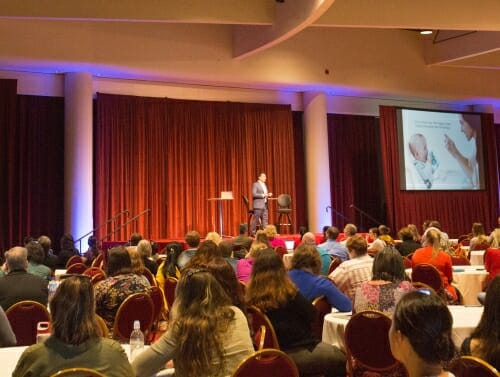35th annual Distance Teaching & Learning Conference explores broader access to higher education
The University of Wisconsin–Madison launched the Distance Teaching & Learning Conference in 1985, when “distance education” meant sending VHS tapes to students through the mail. The tools may have changed, but the mission remains the same for the 35th annual conference Aug. 6–8: providing easier access to higher education through technology. More than a hundred presentations, panels and workshops will explore new ways to reach students using techniques that would have seemed like science fiction in 1985.
The conference will offer a glimpse of the future for nearly 800 higher-education faculty members, staff, instructional designers and workforce trainers at Monona Terrace Community and Convention Center. Internationally recognized experts from UW–Madison and other institutions across North America will explore strategies for giving students more control over where, when and how they pursue an education.
“Distance education harnesses technology to provide learners with more flexibility in choosing their own paths,” says Jeffrey S. Russell, dean of the Division of Continuing Studies and vice provost for lifelong learning. “The Distance Teaching & Learning Conference will delve into the latest research-based approaches for engaging today’s digitally connected students.”

The Distance Teaching & Learning Conference offers a glimpse of the future for nearly 800 higher education faculty members, staff, instructional designers and workforce trainers at Monona Terrace Community and Convention Center. Photo: Sharon Vanorny
The conference will address emerging issues such as virtual and augmented reality, multimedia design and alternative credentials. Keynote speaker Bryan Alexander, author of “The New Digital Storytelling,” will offer a vision of distance education’s next phases and lay out the practical steps for getting there.
A particular focus is the role distance education plays in increasing access. Keynote speaker Robin DeRosa, professor of interdisciplinary studies at Plymouth State University, will show how educational innovation can bring down costs for students. Newton Miller, associate dean for education studies at Ashford University, will explain how distance educators can open doors for at-risk populations.
“The conference will offer solutions for making higher education more welcoming to those who have traditionally faced barriers,” says Wendy Fritz, director of Learning Design, Development, and Innovation at UW–Madison. “Attendees will learn how technological advances can help students progress at their own pace, with built-in support systems available at any time and from anywhere.”
“Distance education harnesses technology to provide learners with more flexibility in choosing their own paths.”
Jeffrey S. Russell
Since the pioneering Distance Teaching & Learning Conference of 1985, distance education has come into its own. It’s at the forefront of innovation in higher education, with VHS tapes a dim memory and mobile learners the new frontier for anytime, anyplace learning.
“The 35th annual Distance Teaching & Learning Conference is a chance for us to celebrate a newly established field that is now changing the world,” says Fritz. “Attendees will learn to use up-to-the-minute tools and techniques to meet a timeless goal: providing a high-quality education to the widest range of students.”
